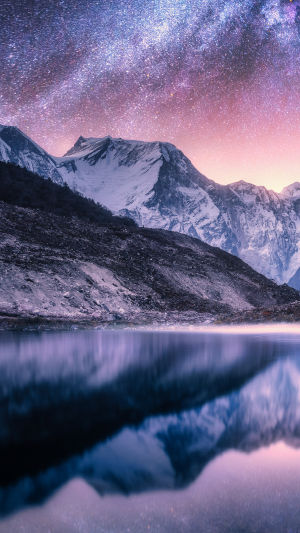The night sky is a mesmerizing sight that never fails to captivate our imagination. As the sun sets and darkness blankets the world, the celestial spectacle unfolds above us, revealing a vast expanse of stars, planets, and cosmic wonders.
At the heart of the night sky are the stars, those distant suns scattered across the cosmos. Each star shines with its brilliance, casting a unique hue against the dark backdrop.
They come together to form intricate patterns known as constellations, evoking stories and legends woven into human culture for centuries.
Accompanying the stars is the radiant presence of the moon. Earth's faithful companion, the moon illuminates the night with its soft glow. From the delicate crescent of a new moon to the majestic full moon, its phases mark the passing of time and inspire a sense of wonder.
In locations free from the grip of light pollution, the night sky unveils its full splendor. Meteors streak across the heavens, leaving trails of shimmering light as they burn up in the atmosphere.
Comets, composed of icy bodies, grace the sky with their ethereal tails when they venture close to the sun. And then there is the grandeur of the Milky Way, a tapestry of stars and nebulae stretching across the celestial sphere, reminding us of the immense scale of the universe.
The night sky has long been a muse for artists, poets, and astronomers alike. It sparks our creativity, drives scientific exploration, and invites us to contemplate our place in the cosmos.
By observing the night sky, we gain insights into the workings of the universe, unravel its mysteries, and deepen our appreciation for the wonders of existence.
Now, let's embark on a journey to discover some of the world's most breathtaking night sky destinations:
1. Atacama Desert, Chile: Renowned for its incredibly dry and stable atmospheric conditions, the Atacama Desert offers unparalleled clarity for stargazing and astrophotography. Its expansive horizons and clear skies make it an astronomical paradise.
2. Big Island of Hawaii, United States: The lofty peaks of Mauna Kea and the observatories nestled atop them provide an exceptional vantage point for observing the heavens. With minimal light pollution and high altitudes, the Big Island offers breathtaking views of the night sky, including the Milky Way.
3. Abisko, Sweden: Situated near the Arctic Circle, Abisko boasts dark, pristine skies perfect for witnessing the enchanting dance of the aurora borealis. The captivating interplay of the Northern Lights with the stars creates a magical spectacle.
4. Lake Tekapo, New Zealand: Nestled on the shores of Lake Tekapo, the Sky Observatory Institute offers a serene and secluded location for stargazing. Shielded from light pollution, visitors are treated to an unobstructed view of the southern hemisphere's celestial wonders.
5. Lofoten, Norway: Often referred to as the capital of the Arctic Circle, Lofoten's dramatic fjords provide a dramatic backdrop for observing the celestial ballet of the aurora borealis. The interplay of vibrant colors against the majestic fjords is a sight to behold.
6. Mount Rapallos, Chile: Perched high in the Chilean Andes, Mount Rapallos is home to several world-class observatories. Its elevation and remote location make it an ideal spot for astronomers and stargazers seeking crystal-clear views of the night sky.
7. Grand Canyon National Park, Arizona, United States: The vastness of the Grand Canyon coupled with its low light pollution creates an ideal environment for stargazing. As the night descends, the stars shimmer above the awe-inspiring chasms, forming a breathtaking panorama.
8. Mount Barbascatto, Chile: Towering at an impressive altitude of 9,000 feet, Mount Barbascatto is the highest volcano in Chile. Situated on the edge of the Atacama Desert, it offers pristine night skies and awe-inspiring views of the stars.
9. Glacier National Park, Montana, United States: With its expansive skies and untouched wilderness, Glacier National Park provides a tranquil setting for immersing oneself in the cosmic wonders above. The unpolluted atmosphere allows for a vivid display of stars and celestial phenomena.
10. Antarctica: The pristine and remote landscapes of Antarctica offer a unique opportunity for stargazing and aurora spotting. Against the backdrop of snow-covered expanses, the stars, and auroras paint a picture of ethereal beauty.
These destinations represent just a glimpse of the world's most magnificent night skies. Every corner of our planet holds its celestial wonders, inviting us to look up and contemplate the grandeur of the universe.
Whether you are an astronomer, an artist, or simply a dreamer, the night sky beckons you to explore, marvel, and find inspiration in its infinite depths.





